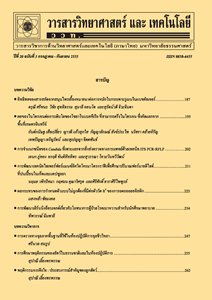การพยากรณ์การเคลื่อนที่ของน้ำมันในแม่น้ำตาปีด้วยแบบจำลองคณิตศาสตร์
Main Article Content
Abstract
บทคัดย่อ
ปัจจุบันแบบจำลองคณิตศาสตร์มีบทบาทในการคาดการณ์ผลกระทบสิ่งแวดล้อม การขนส่งทางน้ำมีความเสี่ยงที่จะเกิดอุบัติเหตุน้ำมันรั่วไหล ซึ่งจำเป็นต้องมีการเตรียมตัวรับมืออย่างระมัดระวัง บทความนี้ได้นำเสนอขั้นตอนและวิธีการต่าง ๆ อย่างละเอียด ในการจัดทำแบบจำลองคณิตศาสตร์เพื่อคาดการณ์การเคลื่อนที่ของคราบน้ำมันในแม่น้ำตาปี จังหวัดสุราษฎร์ธานี การวิจัยเริ่มจากการสำรวจข้อมูลภาคสนามที่เกี่ยวข้อง ได้แก่ ข้อมูลแผนที่ความลึก ระดับน้ำ กระแสน้ำ เมื่อปรับแก้และสอบเทียบแบบจำลองคณิตศาสตร์ด้านการไหลเวียนของกระแสน้ำ (MIKE21 HD) แล้วเสร็จ จะสามารถคาดการณ์ลักษณะการรั่วไหลของคราบน้ำมันได้โดยใช้แบบจำลองคณิตศาสตร์ MIKE21/3 integrated model ผลการศึกษาพบว่าคราบน้ำมันจะเคลื่อนที่ตามช่วงเวลาที่น้ำขึ้นลง ด้วยความเร็วที่อาจมากถึง 1,310 เมตรต่อชั่วโมง ในช่วงน้ำกำลังลง มาตรการรับมือผลกระทบต่าง ๆ ได้ถูกเสนอแนะ บทความนี้นำเสนอรูปแบบการจัดทำแบบจำลองคณิตศาสตรร์ที่ถูกต้องตามหลักวิชาการและอธิบายขั้นตอนอย่างละเอียดถึงการประยุกต์ใช้แบบจำลองเพื่อบริหารจัดการคราบน้ำมัน จึงสามารถนำไปใช้อ้างอิงในวงการด้านแบบจำลองคณิตศาสตร์และสมุทรศาสตร์ของประเทศไทย
คำสำคัญ : คราบน้ำมัน; แบบจำลองคณิตศาสตร์; สมุทรศาสตร์; แม่น้ำตาปี; วิศวกรรมชายฝั่ง; การขนส่งทางน้ำ
Abstract
Numerical simulation has a role in predicting environmental impact. Waterborne transportation bears the risk of oil spill, which must be addressed carefully. This article presents the detailed method to use the numerical models for oil spill trajectory prediction in Tapee river, Surat Thani province. The research began with collecting relevant field data such as bathymetry, tide, and current. After calibrating and verifying the water circulation model, MIKE21 HD, the oil spill model named MIKE21/3 Integrated Model was applied. The results found that the oil would travel in different directions, depending on flood and ebb tides. The trajectory speed could be as fast as 1,310 meters per hour during ebb tide. Mitigation measures were suggested. This article academically demonstrates and elaborately describes how to apply the models for oil spill management, so that it can be a reference for numerical modeling and oceanographic communities in Thailand.
Keywords: oil spill; numerical simulation; oceanography; Tapee river; coastal engineering; waterborne transportation


